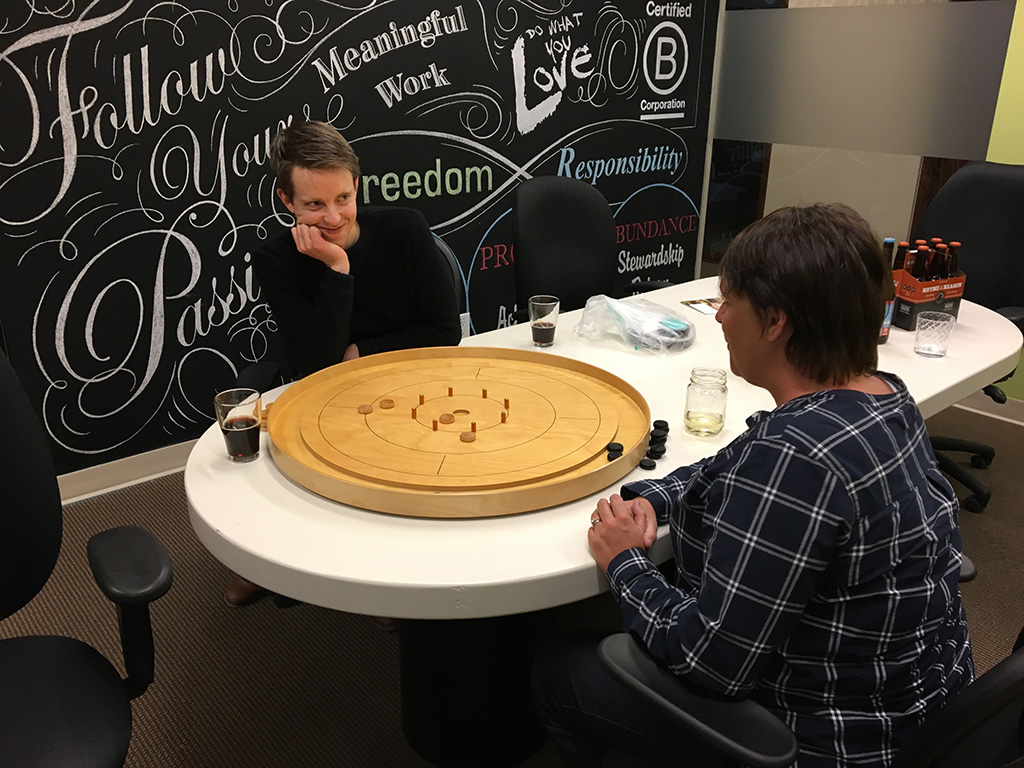Written by Edwin Jansen and published at https://blog.fitzii.com/.This is a followup to a blog also republished by Enlivening Edge, here.
 After six months of self-management we published an article detailing the unfiltered Good, Bad & Amazing comments from our people. Overall there was a lot more good and amazing than bad (or crazy), and we were happy that others found value in hearing about our first hand experiences with self-management.The other day we celebrated our first year of being manager-free with some delicious cake, a heart-warming exercise, and some fun games.
After six months of self-management we published an article detailing the unfiltered Good, Bad & Amazing comments from our people. Overall there was a lot more good and amazing than bad (or crazy), and we were happy that others found value in hearing about our first hand experiences with self-management.The other day we celebrated our first year of being manager-free with some delicious cake, a heart-warming exercise, and some fun games.
We also asked the team to answer some of the most common questions that we get from those curious about what really happens when a company gets rid of management. Here’s the skinny.
What has been the business value of self-management?
This is the most common question we get from those who are skeptical about whether a self-managing company can produce results like a tightly managed business can.
It’s tough to answer because we went all in with self-management, and didn’t have any part of our business that remained “managed”. There’s no A/B test that can prove the difference in results, and we can’t look at results before and after our transition because we’re a young company on a growth trajectory regardless of org structure.
The only way to answer this question is to point to the things that are clearly different, new, or improved since self-management started. With this in mind, the biggest difference-maker in our business results has been the quality of our decision making.
James, from our Hiring Success Team, put it well when he said that these days, instead of ideas being hatched in a vacuum, or worse, coming down in isolation from above, “the best ideas have a chance to surface organically and be thoughtfully considered. With less fear, politics, egos, and bureaucratic boundaries, everyone is free to contribute to decisions in the best way they can.”
For Fitzii, this means our big decisions have been more widely informed and nuanced, resulting in fewer biased, bad calls and more balanced, well-reasoned decisions. Plus, it used to be that someone with a title could drive through a decision that others weren’t on board with, and now those bad ideas die on the vine.
It’s important to note that this inclusiveness in decision making hasn’t meant that we’ve been slowed down by bureaucracy, or that each decision goes through a democratic process. Instead, important projects and decisions are driven along publicly within the team’s communication vehicles. This means that people who have opinions and want to help will pitch in, and others opt out. The right amount of energy and input flows to the decision, and its speed becomes a function of people’s priorities. There is an elegant efficiency to the decision making “advice process” that would make Darwin proud – it’s like the natural selection of ideas.
And for inconsequential calls, we have fun using our “Executive Decision Maker”, which Greg from Product Development made as Fitzii’s version of the Magic 8-Ball.
 We’ve also found that self-management has been like a turbo-boost for the continuous improvement of our people and our offerings. James has pointed out that “accountability to a team instead of an individual means everyone gets more regular feedback from a wider variety of sources. And more feedback has meant we grow and improve our skills faster, and provide better service to our clients.”
We’ve also found that self-management has been like a turbo-boost for the continuous improvement of our people and our offerings. James has pointed out that “accountability to a team instead of an individual means everyone gets more regular feedback from a wider variety of sources. And more feedback has meant we grow and improve our skills faster, and provide better service to our clients.”
Another clear business benefit has been our increased ability to attract and engage top talent. Although Fitzii’s own offering is a hiring platform that helps small businesses hire better, we’ve probably found the biggest improvement to our own hiring has been the attraction of the self-management structure.
Greg found that when looking for in-demand developers, self-management, “was a real plus,” that differentiated and attracted coders to Fitzii. And Andy, one of those star developers that we recently hired, couldn’t agree more. “When I first learned that Fitzii didn’t have managers I thought – this is the type of environment I want to be a part of. Being given the freedom to make an impact is one of the most important things I was looking for in a company.”
Luz, from our Hiring Success Team, pointed out that, “we have been able to attract incredibly intelligent and talented people because we offer something greater than a big paycheque or fancy title. We provide meaningful work on a great team, and we work in a way that is uplifting and exciting, where each person sees the difference they make.”
And Ron, a Hiring Advisor who also recently joined the team, felt the same way:
As a job-seeker, I was looking for an opportunity to leverage my skills and experience right away. More than salary or position title, I really just wanted to contribute and have an impact. The structure at Fitzii has allowed me to do that in an immediate and meaningful way. While many of my friends are struggling with entry-level tedium and stifling bureaucracy, I come to work knowing I can make a difference.
And finally, a measurable business value we have seen is in our team’s employee engagement scores. Every year we participate in the Great Place to Work survey, which asks each person to rate their satisfaction in 58 areas. This year we found that our overall engagement results improved to a nearly perfect score.
Greg felt like self-management was the biggest difference maker. “It’s great for employee engagement, and the resulting productivity, positive feelings and sense of working toward a common purpose.” This makes sense. Gallup has reported that as much as 70% of the variance in employee engagement can be traced back to the manager’s influence. When you remove managers, each person is made responsible for their own role design and engagement, and for addressing any issues that arise – the result is that they end up really happy at work (and at play).
How have you most grown or benefited from self-management?
Self-management is like a leadership development program on steroids. It replaces classroom leadership learning with continuous real-life development – you literally can’t get much done unless you can genuinely work to lead and influence. I’ve personally gotten more direct and indirect feedback about my leadership style in the last year than I had in the previous five years as a manager.
For James, and many others on the team, our focus on, “bringing your whole self to work,” has been a major benefit of the move. “I don’t need to pretend to be one thing at work and wait to get home to be real,” he said. The concept of “wholeness” is a big part of the Teal movement, and Fitzii consciously created wholeness practices that helps everyone feel comfortable to be themselves at work.
It turns out that it’s really draining to be different at work. When you make genuine connections with your colleagues, and come to know that they appreciate you for being you, the quality of your relationships skyrockets. Ian, from our Product Development team, feels like “I’m now on a team that has an incredibly high level of openness, authenticity and trust. Working in this environment is truly awesome.”
The other major benefit we’ve seen stems from self-created role design. Deciding who does what is a big part of traditional management’s role, and it’s an area that is often done poorly – at least from the perspective of the employees who want to maximize their enjoyment of assigned tasks.
According to a well-reasoned book on work motivation called Primed to Perform, the level to which an employee enjoys their work tasks is statistically the most powerful driver of motivation and performance. In the self-management structure, it is each person’s responsibility to look at what has to be done in the business, and match their role with what they’d most like to do, and would be best at doing.
James has found that, “the fluid nature of roles has given me many opportunities to take on new challenges that I wouldn’t get at another company.” And Jonna, from our Sales & Marketing group, said, “I’ve grown the most by having to stretch my creative side. Here I’ve taken on initiatives that would have traditionally been handled by management, and that’s been super motivating.”
What has been the hardest thing about self-management?
Probably the most common difficulty with self-management is all the responsibility that comes with it. James summed this up well:
There’s no place to hide and no space to complain. If you see something that could be better, or that you want to change, the onus is on you to bring it up. With all the freedom, there is also ultimate responsibility.
Carla, from our Hiring Success team, felt that the hardest thing was not in coming up with new self-managing practices, but rather implementing them when the rubber hit the road:
It’s not a “set-it and forget-it” scenario. In a few cases we found holes and misinterpretations. When you implement a new self-management practice, it will likely go through multiple phases. The creation of it, followed by a probationary period to see how it’s working, and then more dialogue and revisions to improve the practice.
For Jonna, the hardest thing was creating new lines of communication between departments. She feels like, “everyone is working hard but we’ve needed to more thoroughly communicate what we are doing and make sure we are all working towards the same goals.”
And finally, Ian had a nice analogy to share about what he found hard about self-management:
I play squash and occasionally get a lesson. The pattern is always the same – my coach suggests I change something fundamental about my game. I incorporate the change into how I play and… I start losing more. Over time, if I stick with it, my game improves and ends up at a higher level than before making the adjustment. It’s the same here. All of us have had to relearn how we work and I found it a challenge to deal with the short term negative impact on performance. There were definite examples of where the transition impacted our ability to achieve our goals. Now though, I’m glad we stuck with it as we’re unquestionably “playing” at a much higher level.
What was the biggest mistake we made?
A few people, like Carla, felt like we, “didn’t make any BIG mistakes,” when rolling out self-management. For anyone hoping to hear stories of massive self-set salary increases, nefarious leadership uprisings, or frivolous rogue spending, we’re sorry to disappoint you.
There were some smaller mistakes and certainly lots of bumps on the road though.
Greg felt like, “a couple times we missed appointing a single decision-maker on a key project, which meant that not enough got done. We learned that it’s important that someone be accountable for any decision that’s worth making.”
I personally made the mistake of initially interpreting self-management to mean that I should take my foot off the gas in driving strategic change across the business, because this was now everyone’s responsibility.
After some time, I realized that this kind of work was simply a task that needed to be done. The only difference was that playing a role which involved organizational-wide change no longer meant I could force-feed new initiatives or tell others what to do.  Instead, it has become a leadership responsibility to shepherd a process where the evolution of strategy arises through engaging interested clients, partners and colleagues, spurring creative discussion, and facilitating decisions.
Instead, it has become a leadership responsibility to shepherd a process where the evolution of strategy arises through engaging interested clients, partners and colleagues, spurring creative discussion, and facilitating decisions.
This is the way I should have been leading in the first place, because pulling out the right strategy along is much more effective than pushing it.
And finally, about halfway through the year we realized that with no clear leadership roles responsible for the entire business, we had fallen off in our communications with our parent company, who had been used to having regular dialogue with the former managers. Like everything else, this is simply a task that needs to be done, so we created a monthly meeting with assigned roles, and public visibility of the notes from the meeting.
What are things we still need to change or start doing?
When we made the call to implement self-management, we also decided to take it slow. Managers had a lot of responsibilities, and there are many key processes that hinged on their roles. We thought it would be too chaotic to change everything at once, so instead we identified certain elements, like compensation setting, performance reviews, hiring/firing, and vacations, which we would tackle as practices to overhaul as the year went on.
This ended up working well. In each case one person took the lead, like Greg blogged about with performance reviews, and used the advice process to come up with a new structure. But we’re not totally done with the transition. There are a few areas we still need to work on.
Ian feels like we have more work to do in encouraging performance feedback and difficult conversations:
I sense that we’re doing a great job of the positive reinforcement, but aren’t quite there yet in giving constructive feedback that will help others grow and develop. I think we’ve perhaps been “over-careful” and avoided feedback that could be construed as coming from a place of authority, i.e. a vestige of our previous hierarchical structure.
This has been a major aha for many of us. A self-management structure means there is a radical responsibility for everyone to own each problem they see, whether it’s with a process or a person. In a traditional management structure, if you identify a problem, you typically bring it to the manager in charge of that area. At Fitzii, you have to figure out how to address it directly with the people involved.
Having constructive and courageous conversations is a skill that needs to be practiced and developed, and we could certainly benefit from some training and attention in this area in the next year.
Greg also pointed out that although we did make the big jump to self-setting compensation, we weren’t able to get as consistent as we would have liked, because, “some on the team have contracts that would be difficult to rework at this point. The plan is to revisit this next year, and come up with a more unified compensation structure that applies to everyone on the team.”
What advice would you give to other organizations?
First off, Jonna points out something we’d all agree on, which is that any organization implementing self-management should not just “flip a switch” and should, “expect this to be a transition that takes many months to work through.”
Greg felt that we had an advantage starting as a small organization (10 people) that already functioned with a fair bit of self-management. This led to a smoother transition during which we were able to figure out our policies as we went, and the bumps along the way had minimal impact. On the other hand, “a larger or more hierarchal organization, would do well to have these new policies mapped out and planned before starting the transition.”
Luz would emphasize how important it is to, “focus on having clearly articulated strategies, plans, and roles that engender clarity, purposeful work and decision-making. And it’s critical to also build a framework and expectation for feedback.”
And finally, Carla talked about how important it is that, “your team is really into it.” This can’t be something that only the existing leadership wants:
Going on this journey with a group of people who are so devoted to the mission makes all the difference. When there is conflict or disagreement on our team it’s always about interpreting and deciding which path is the truest and most fitting form of self-management for our team. It’s rarely, if ever, about doubting the path we’re on. It’s critical that the team is moving forward towards a common goal – having naysayers around would be detrimental.
Going forward
All in all, it’s been an exciting and growth-filled transition into self-management. We’re going to keep writing about our experiences, so if you’d like to follow along, you can sign up for the blog (in the footer or top right of this post).
 If you are interested in increasing empowerment and engagement at your organization, we’d also recommend that you check out Reinventing Organizations, as well as some of the other 25 powerful books that shaped our company.These books are sure to inspire you to build a better business.
If you are interested in increasing empowerment and engagement at your organization, we’d also recommend that you check out Reinventing Organizations, as well as some of the other 25 powerful books that shaped our company.These books are sure to inspire you to build a better business.
We hope answering these questions about our journey was helpful. If you have any more you’d like us to answer, or if you have your own comments to make, we’d love to hear from you below.






Thanks for this story, it is great to read stuff like this. How did you make the transition in salaries, given the fact that former managers probably earned more then certain people in the company?
thanks,
Steven.